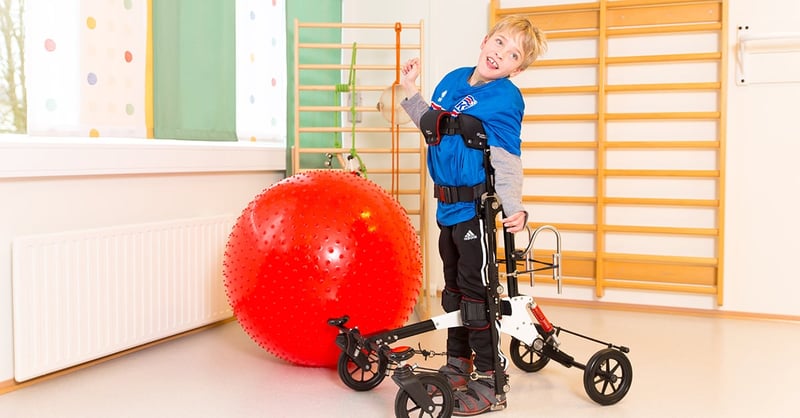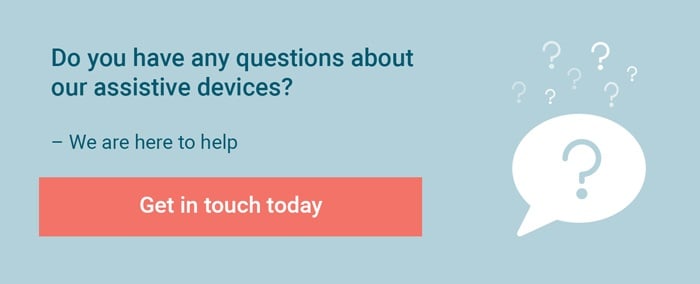What your child can gain from using the NF-Walker


The NF-Walker is a unique gait trainer that enables your child to move around independently in an upright position. Already at the age of 12 months your child can benefit from using the device to explore the surroundings, be active and participate.
What is unique with the NF-Walker?
The NF-Walker is defined as a gait trainer. A gait trainer offers more support compared to a typical walking aid. This means the NF-Walker supports your child all the way from the feet to the head (if needed) to facilitate alignment in both standing position and while walking. What really sets the NF-Walker apart from other devices is the unique bracing system and hands-free walking. The bracing system assures correction of the legs whether your child is weak, have low muscle tone or has a high degree of spasticity. Hands-free walking, allows the child to interact in play with other children or with you as parents. Let your child hold hand with another child while walking.

The device is customised to fit your specific child’s needs for support, to initiate and stimulate motor development and enable independent movement.

Who can benefit from using the NF-Walker?
A gait training device has the purpose of supporting your child’s development, increasing independence, and letting the child explore the world despite of its disability. The device is mainly used by children and young people with disabilities where independent walking or walking with light support is not achievable, for example with the diagnosis of CP, GMFCS levels III, IV and V. The unique, individualised support enables even severely disabled to be aligned in standing and walk on their own.
At what age can my child start using the NF-Walker?
Children usually start to sit on their own when they are 6-7 months old and walk from 12 months of age. If your child has a disability you may experience that motor function is delayed and your child is not meeting the milestones as expected. To allow the child to be in a position you will probably need to support him or her with your hands. Assistive devices, such as special seating systems, wheelchairs, and standing and walking devices, have the purpose of supporting the child in positions that he or she is not able to achieve, allowing:
- Independency
- Mastery
- Development of new skills
- Activity
- Participation
- Exploration of surroundings

For example will supported sitting in a seating system stabilise the child and allow for improved use of the hands (playing with toys, eating, drawing etc.) In a standing position the child will experience being at the same level as peers, and in a walking device the child will be able to walk on its own, be mobile, participate in activity and engage with peers.
Assistive devices also free up your hands as parents. Instead of supporting your child with your hands you can play, train new skills and interact with your child. It gives both you and your child more freedom.
In general, it is recommended to introduce assistive devices in an age where the function naturally would have developed. So, when it comes to the gait trainer NF-Walker, it can be introduce around 12 months of age. The extensive support system allows even children with severe physical disabilities the possibility to stand and walk around on its own.
Ella is a cheerful, expressive and social 3 ½-year-old girl, who started to use the NF-Walker when she was two years old. She tried several different walking device, but ended up with NF-Walker as this was the only gait trainer supporting her well enough to master walking. Her parents explain so well the importance of letting Ella explore the world on her own, touching things, opening cupboards, tossing flowers and having the opportunity to be a little naughty without adult interference. Read the full interview of Ella’s parents here.
What can my child gain from using the NF-Walker?
First and foremost, the NF-Walker enables your child to move around independently in an upright position. Being able to move around with hands free, your child can more easily participate in and perform different activities.
Being in an upright position gives your child an opportunity to interact with others. It enables play, participation, and communication with peers at eye level, which can create a better sense of control, safety and connection. Having the ability to participate in social settings can also lead to a higher sense of well-being for the child (Pin, 2007).
Letting the child stand and walk in the NF-Walker may also positively affect physical health, such as:
- bone mineral density
- prevent contractions and deformities, as well as reducing muscle tone
- respiration and circulation
- gastrointestinal function
Read more: 12 frequently asked questions about the gait trainer NF-Walker
What to do if I want to try the NF-Walker?
The system for reimbursement when purchasing assistive devices varies from country to country. We recommend that you start by contacting your local Made for Movement office or distributor for more advice on how to proceed. If we are not represented in your country of residence, you can contact our head office in Norway directly.

References
- G.S. Paleg, B.A. Smith, L.B. Glickman, Systematic Review and Evidence-Based clinical Recommendation for Doing of Pediatric Supported Standing Programs, Pediatric Physical Therapy 25(3):232-247, 2013
- R.C. Henderson, R.K. Lark, M.J. Gurka et al; Bone Density and Metabolism in Children and Adolescents With Moderate to Severe Cerebral Palsy, Pediatrics, 2002, vol. 110
- O. Verschuren, V. Leferink, J. Darrah, Muscle activation and energy-requirements for varying postures in children and adolescents with cerebral palsy, J Pediatr. 2014 November; 165(5): 1011-1016
- O. Verschuren, M.D. Peterson, A.C.J. Balemans, E.A. Hurvitz, Exercise and physical activity recommendations for people with cerebral palsy, Dev. Med child Neurol., 2016 Feb 7. doi: 10.1111/dmcn.13053
- T.W. Pin, Effectiveness of static weight-bearing exercises in children with cerebral palsy, Pediatr Phys Ther. 2007 spring; 19(1):62-74

Jens Kleine is a physiotherapist with many years of sales experience within assistive device technology across several European countries. He is very focused on users’ needs and dedicated in finding innovative solutions. Today, Jens has a product manager role working closely with both external clinicians, the salesforce and our R&D team. Always searching for solutions that bring movement to the people that need it most.
ACE SMA is a charity organization in the UK, aiming to raise money to fund clinical research. They are currently funding a study...
Innowalk has become crucial in Melvin's life. It is a device that not only improves his motor skills and mobility but also enhances...
Dr. Dawn M. Pickering created his vibrant illustrated storybook as part of her study to explore the wellbeing of individuals with...
Hear from us from time to time and learn new things